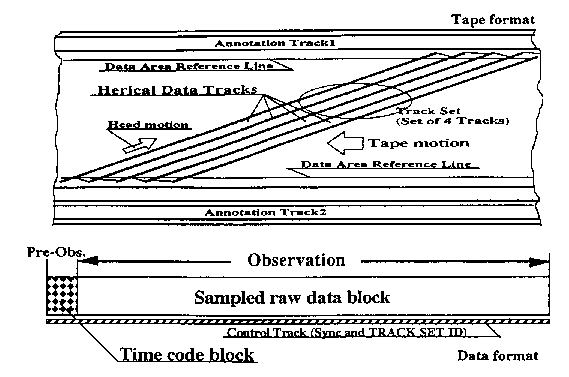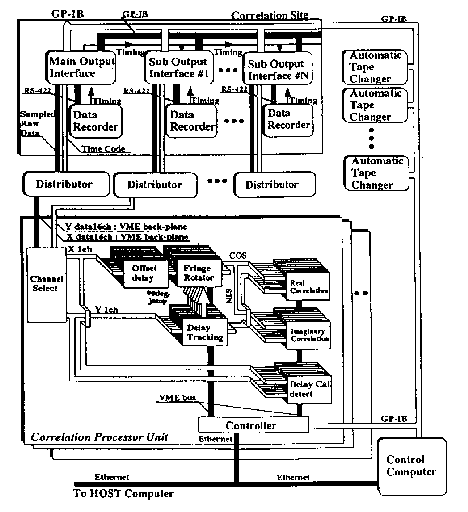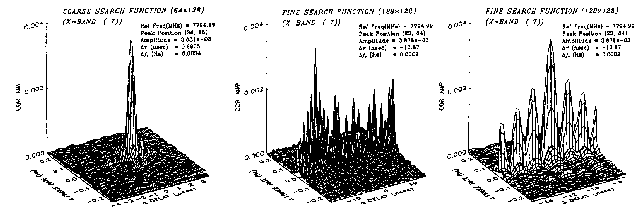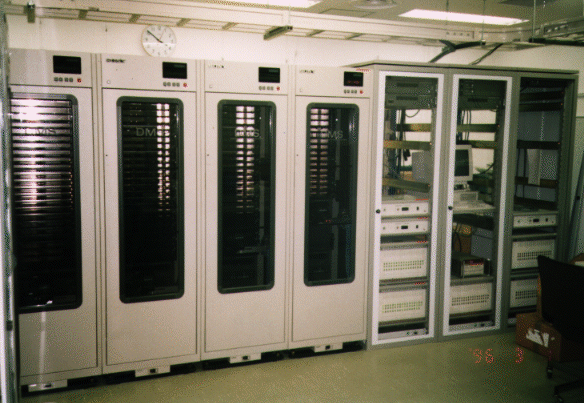Correlation Processing System for the Key-Stone Project
Hitoshi Kiuchi
Communications Research Laboratory
4-2-1 Nukui-kita, Koganei, Tokyo 184, Japan
Abstracts
We have developed an XF type VLBI correlation processor by making use of
Field Programmable Gate Arrays. This correlator was specially designed
for the Key-Stone Project, which is concerned with measuring crustal
deformation in the Metropolitan area. The outline of the correlator is
(1) Automatic bit synchronization during multi-baseline processing, (2)
Network Filing System for storing correlated data, (3) maximum data rate
is 512 Mbps, (4) 2-bit and higher sampled data processing capability,
(5) 16ch high speed (32 Mbps/channel) processing, (6) Compact and
light-weight, (7) Signal provided by VME back plane. Using this new
correlator, we can improve the precision of the geodetic VLBI and also
contribute to radio astronomy VLBI.
1. Correlation Processing System
The periodicity of the time code is not required for spectrum analysis.
Only the sampled data are needed. The K-4 recorder has helical data
tracks, two longitudinal annotation tracks and a control track (Fig.
1). The Track Set ID numbers are recorded on the control track, and can
be read at any tape speed even during fast forward or rewind. The
output interface unit can control the synchronous replay of several Data
Recorders, convert the Track set ID for the data clock, and send data to
a correlator. There is an obvious relationship between the Track Set ID
(which is a head control signal written on the control track) and the
time code block. It is possible to manage the time code using the Track
set ID and Time code block. For a few seconds the time code data is
over written on the data train in a pre-observation header block. After
the time code block, data timing is checked by the Track Set ID, which
means that the output data is only digitized raw data during an
observation.

Figure 1. Tape format and data format

Figure 2. Block diagram of correlation processing system
In the multi-baseline correlation processing, all the output interface
units are daisy-chain connected via GPIB and a timing control line. A
block diagram of the correlation system is shown in Fig. 2. Therefore,
the tape position data and the status data of all the data recorders can
be exchanged via the output-interface units. The replayed data from the
data recorder is written into a buffer memory. The measured phase
difference between the replayed and the external 1 PPS signal sent from the
Main Replay system is monitored by the clock. The measured data is then
sent to the main replay system, and used for the bit synchronization
(fine synchronization) between the main and sub replay systems. The
main replay system (the main output interface unit and the data
recorder) and the sub replay system (the sub output interface unit and
the data recorder) can be synchronized in one-bit steps. The delay
adjustment is done by controlling the track set ID position control and
subsequent programmable memory. The signal (raw data) is unformatted
instead of in the Mark-III format. We are developing an XF type VLBI
correlation processor for the K-4 system by making use of Field
Programmable Gate Arrays. The outline of the correlator is:
- (1) Automatic bit synchronization during multi-baseline processing,
- (2) Network (Ethernet) Filing System for storing correlated data,
- (3) 2-bit or higher sampled data processing capability,
- (4) 16 ch high speed (32 Mbps/channel) processing,
- (5) Compact and light-weight,
- (6) Signal provided by VME back plane.
And specifications are;
- (1) Fringe phase resolution 32 bit (at K=1),
- (2) 28 bit integrator (integration time from 1 sec to 16 sec),
- (3) maximum clock rate 32 MHz,
- (4) Phase calibration signal detector (Pcal detection frequency from 10 kHz to
9990 kHz),
- (5) 256 kbit delay tracker,
- (6) A priori calculation is done each correlator,
- (7) 32 complex lags in each channel,
- (8) 16 ch XF type correlator,
- (9) fringe search mode (512 lags).
This correlator was specially designed for the Key-Stone Project, which
is concerned with measuring crustal deformation in the Metropolitan
area. The detected fringes are shown in Fig.3, and geodetic results
are reported in this issue. The project utilizes 4 stations in the
Metropolitan area, and each station has a new K-4 system and an 11-m
antenna. Using this new correlator, we can improve the precision of the
geodetic VLBI and also contribute to radio astronomy VLBI. The
multi-baseline correlation processor (4-station) is shown in Fig.4.
It is also possible to use this correlator for real-time VLBI.

Figure 3. Detected fringes

Figure 4. Developed multi-baseline correlation processing system.
From left : 4 DMS (Digital Mass-strage System: automatic tape changer)
2. Conclusion
The KSP (new K-4) data acquisition mode includes VLBA and VSOP data
modes. Multi-baseline correlation processors using Field Programmable
Gate Array has been developed.
References
[1] Cooper, "Correlators with Two-bit Quantization", Ast. J. Phys., vol.23, pp.5
21-527, 1970.
[2] A.E.E.Rogers, A.E.E.; "Coherence Limits for Very-Long-Baseline Interferome
try", IEEE Trans. Instrum. Meas., vol. 30, pp. 283- 286, December 1981.
Updated on June 25, 1995.
Return to CONTENTS




